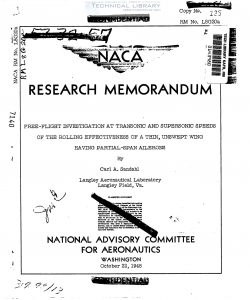naca-rm-l8g20a
- Version
- 77 Downloads
- 420.19 KB File Size
- 1 File Count
- April 26, 2017 Create Date
- April 26, 2017 Last Updated
National Advisory Committee for Aeronautics, Research Memorandum - Free-Flight Investigation at Transonic and Supersonic Speeds of the Rolling Effectiveness of a Thin, Unswept Wing Having Partial Span Ailerons

An investigation of the rolling effectiveness at transonic and
supersonic speeds of a thin, unswept wing having partial-span ailerons
has been made by means of rocket-propelled test vehicles. The results
showed that with h.6° aileron deflection, the only deflection tested,
the rolling effectiveness decreased abruptly in the Mach number range
from about 0.92 to 0.97. At supersonic Speeds the rolling effectiveness
was considerably lower than at subsonic speeds. The direction of roll
was in the correct sense over the entire Mach number range investigated;
In the course of an investigation of wing-aileron rolling-
effectiveness characteristics at transonic and supersonic speeds being
conducted by the Pilotless Aircraft Research Division of the Langley
Laboratory, utilizing rocket-propelled test vehicles in free flight,
a thin, unswept wing having partial-span ailerons was tested. The
wing tested had zero sweepback at the 50-percent-chord'line, an
aspect ratio of 4.0, a taper ratio of 0.5, and employed modified
symmetrical double-wedge airfoil sections of 4.6-percent thickness
ratio normal to the 50-percent-chord line. The ailerons had a constant
chord equal to 35 percent of the wing-tip chord and extended over the
outboard 25 percent of the wing semiSpan. Two identical models having
h.6° aileron deflection were tested. The tests, which were made by
means of the free-flight.technique described in references 1 and 2,
permit the evaluation of the wing-aileron rolling effectiveness over
the Mach number range from about 0.6 to 1.8 at relatively large scale.
The tests were made during May l9h8.
| File | Action |
|---|---|
| naca-rm-l8g20a Free-Flight Investigation at Transonic and Supersonic Speeds of the Rolling Effectiveness of a Thin, Unswept Wing Having Partial Span Ailerons.pdf | Download |

Comment On This Post